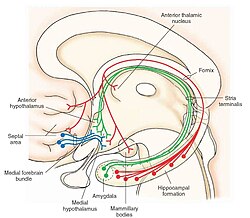Medial forebrain bundle
| Medial forebrain bundle | |
|---|---|

Anatomical diagram of medial forebrain bundle. These neural fibres connect the septal area in forebrain with medial hypothalamus.
|
|
| Details | |
| Identifiers | |
| Latin | fasciculus medialis telencephali |
| MeSH | Medial+Forebrain+Bundle |
| NeuroNames | hier-416 |
| NeuroLex ID | Medial forebrain bundle |
| Dorlands /Elsevier |
f_03/12356134 |
| TA | A14.1.08.955 |
| FMA | 62064 |
|
Anatomical terms of neuroanatomy
[]
|
|
The medial forebrain bundle (MFB), is a neural pathway containing fibers from the basal olfactory regions, the periamygdaloid region and the septal nuclei, as well as fibers from brainstem regions, including the ventral tegmental area.
The MFB passes through the lateral hypothalamus and the basal forebrain in a rostral-caudal direction. It contains both ascending and descending fibers. The mesolimbic pathway, which is a collection of dopaminergic neurons that projects from the ventral tegmental area to the nucleus accumbens, is a component pathway of the MFB.
It is commonly accepted that the MFB is a part of the reward system, involved in the integration of reward and pleasure. Electrical stimulation of the medial forebrain bundle is believed to cause sensations of pleasure. This hypothesis is based upon intracranial self-stimulation (ICSS) studies. Animals will work for MFB ICSS, and humans report that MFB ICSS is intensely pleasurable.
Another research technique that was used in determining the function of the MFB was microdialysis. Reinforcing electrical stimulation of the MFB using this method has shown to cause a release in dopamine in the nucleus accumbens. Other microdialysis studies that have been performed have shown that the presence of natural reinforcers such as food, water, and a sex partner, have found to cause a release in dopamine in the nucleus accumbens. This shows that the electrical stimulation of the MFB causes a similar effect compared to natural reinforcers.
...
Wikipedia
